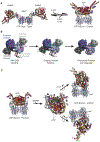The dynamic nature of the Mre11-Rad50 DNA break repair complex
- PMID: 33121960
- PMCID: PMC8065065
- DOI: 10.1016/j.pbiomolbio.2020.10.007
The dynamic nature of the Mre11-Rad50 DNA break repair complex
Abstract
The Mre11-Rad50-Nbs1/Xrs2 protein complex plays a pivotal role in the detection and repair of DNA double strand breaks. Through traditional and emerging structural biology techniques, various functional structural states of this complex have been visualized; however, relatively little is known about the transitions between these states. Indeed, it is these structural transitions that are important for Mre11-Rad50-mediated DNA unwinding at a break and the activation of downstream repair signaling events. Here, we present a brief overview of the current understanding of the structure of the core Mre11-Rad50 complex. We then highlight our recent studies emphasizing the contributions of solution state NMR spectroscopy and other biophysical techniques in providing insight into the structures and dynamics associated with Mre11-Rad50 functions.
Keywords: Allostery; DNA double Strand break repair; DNA repair; Methyl TROSY; Mre11-Rad50-Nbs1; NMR spectroscopy.
Copyright © 2020 The Authors. Published by Elsevier Ltd.. All rights reserved.
Figures



References
-
- Al-Ahmadie H, Iyer G, Hohl M, Asthana S, Inagaki A, Schultz N, Hanrahan AJ, Scott SN, Brannon AR, McDermott GC, Pirun M, Ostrovnaya I, Kim P, Socci ND, Viale A, Schwartz GK, Reuter V, Bochner BH, Rosenberg JE, Bajorin DF, Berger MF, Petrini JHJ, Solit DB, Taylor BS, 2014. Synthetic Lethality in ATM-Deficient RAD50-Mutant Tumors Underlies Outlier Response to Cancer Therapy. Cancer Discov. 4, 1014–1021. 10.1158/2159-8290.CD-14-0380 - DOI - PMC - PubMed
Publication types
MeSH terms
Substances
Grants and funding
LinkOut - more resources
Full Text Sources
Other Literature Sources
Research Materials
Miscellaneous

